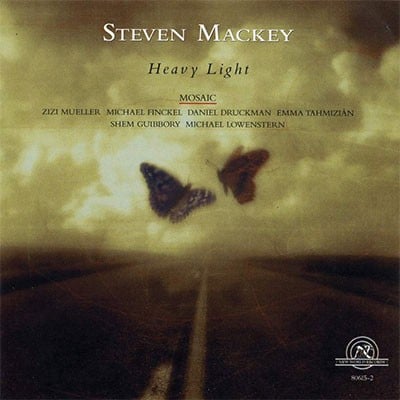fl(=picc).cl(=bcl)-pft-vln.vlc
solo perc:BD/med tom-t/high tom-t/tuned cowbell/2congas/claves/sm high tgl/susp.cym/pedal kick BD/
low tom-t/low Asian dr/low Samba whistle/clickers/bongos/2timbales/wdbl/2piccolo wdbl/sm cowbell/
log dr/mounted cast/sm guiro/egg shaker/mounted tamb jingles/vibraslap/sizzle cym/Chinese cym/
crash cym/sm Chinese gong/cans/bean pod rattle/bottles
Abbreviations (PDF)
Boosey & Hawkes (Hendon Music)
- Chords and Fangled Drum Set
- Interlude #1 Vibes Solo
- Click, Clak, Clank
- Interlude #2 Marimba and Cello
- Tune in Seven
Several years ago I attended The Percussive Arts Society National Convention. There I witnessed a ninety-minute clinic on state of the art techniques for playing crash cymbals. I confess that there was something humorously esoteric about the event, but I left inspired to imagine particular ways to coax sound out of pieces of wood, metal and skin instead of simply hitting things. It also woke me to the fact that the first step in writing for percussion is to invent the instrument and a playing technique. Percussionists tend to have an adventurous attitude about this: if they can reach it with an arm or leg, or hold it in the mouth it is fair game. I'm fascinated by the one-man-band mentality of juggling contrasting timbres produced by a gamut ranging from finely crafted instruments to kitchen utensils, and hobby shop paraphernalia.
In addition to providing a virtuoso "vehicle" for the percussionist, Micro-Concerto also explores a variety of more complex roles that the individual can play in relation to the ensemble. In movement I: Chords and Fangled Drum Set, the rhythm is front and center. I imagine that the piano chords harmonize the rhythm instead of the rhythm measuring the harmonies.
Movement II: Interlude #1 Vibes Solo, is a short, lyrical ballad.
In Movement III: Click, Clak, Clank, the percussionist is neither an accompanying rhythm section nor leading melody. I think of it as a contextualizing and interpreting narration spoken in some imaginary tongue clicking language.
In Movement IV: Interlude #2 Marimba and Cello, the two instruments are completely co-dependent; the story is told only by their interplay. In some sense they are a single instrument with timbres no more disparate than the clickers and samba whistle that are part of the percussionist's instrument in movement III. This movement flows without pause into movement V: Tune in Seven. In the first half of the movement the percussionist is one of six players tossing around a set of variations on the Tune. Toward the end the percussionist returns to the "fangled drum set" and shifts the focus back to what must be (along with singing) the most fundamental form of musical expression—hitting things in time.
The two interludes are played on big, standard pieces of percussion "furniture," but the main movements focus on small moves and subtle distinctions. They are full of fussy descriptions of how to play some hand-held "toy" just so. This micro-management of small muscle groups, and the fact that the concerto soloist is accompanied by the smallest orchestra imaginable, suggested the title.
Micro-Concerto was commissioned by a Meet the Composer grant for the New York New Music Ensemble, the San Francisco Contemporary Music Players, and the California E.A.R Unit.
Steven Mackey, 1999
Reproduction Rights
This programme note can be reproduced free of charge in concert programmes with a credit to the composer

Mosaic
New World NW80615

